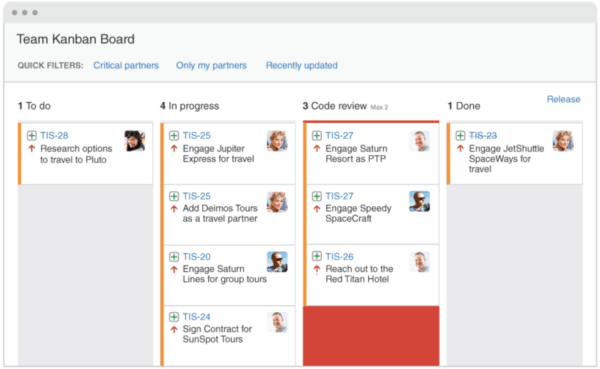Project management tools are the foundation of successful development teams, designed to enable them to be agile, have total visibility, easily distribute tasks, and automate workflows.
Jira Software was initially designed to allow software developers to implement agile project management. Its strengths lie in the ability to adapt to any type of process. That’s why today Jira has really expanded its usability to perfectly suit all types of teams, not just developers.
Trello, on the other hand, has built a great reputation and loyal following around its intuitiveness and simplicity in handling tasks.
So here’s the punchline. Since the acquisition of Trello by Atlassian in 2017, teams have been debating whether Trello or Jira would best suit their business needs. And the answer to that question is: it depends.
I know that’s not the straightforward answer you might have been looking for. But both have characteristics that might swing the vote to either side.
Nevertheless, I’ll do my very best to help you solve some main questions you might have. As the title suggests, in this article I will mainly focus on the advantages of Jira.
Why Jira?
There is a multitude of applications on the market aimed at agile project management.
But as the boundaries between traditional teams break down and organizations encourage more collaboration, the audiences for these tools are merging.
The software development team is changing and is no longer a separate entity working in a silo from the rest of the business.
Software influences Product Marketing, Marketing influences Sales, Product Management influences Marketing, and so on. There are similar needs and requirements across all teams who want to manage multiple projects effectively.

Taking Marketing as an example, tools like Trello are targeted at these non-software teams who need to demonstrate flexibility and creativity, and it plays on the assumption that tools like Jira will enforce rigidity and control.
This simply isn’t the case…
Jira was designed for software development to take complex and multidimensional projects and workflows and make them palatable and simple to understand.
This needs to essentially create, assign, and move tasks and the information relates to any agile scenario.
1. Jira’s balance of a Simple Design with Complex Capabilities
The art of design is to transform something with increasing complexity into something simple and easy to understand.
Trello is an electronic version of a whiteboard with superpowered Post-it notes, it’s simple.
But Jira really captures the essence of team cooperation by using Trello’s visual simplicity and supercharging it with extensive, yet intuitive functionality.
With Jira, you get the best of both worlds:
- The intuitive ‘board’ style of Trello, can be customized to your preferred project management process (whether it’s Kanban, Scrum, or Waterfall).
- With additional logic and features. A great UX / UI with the task management power behind it that Trello just doesn’t have.

Trello relies on its simple design and user experience. To read more about managing projects using Trello, check out this blog post.
But stacked against Jira’s combination of a great user interface with powerful functionality, Trello has no chance.
2. There’s an Add-on for that…
Jira is a tool built with change in mind.
As part of the ample functionality of the Atlassian suite, this application has the great appeal of being as simple or as complex as needed.
And where basic functionality falls short, there is always a Jira plugin available in the Atlassian Marketplace.

Would you like to automate recurring tasks? There’s an app for that. Looking to transform your Jira into a CRM? There’s an app for that. Looking to do a live migration from one instance to another? You guessed it, there’s an app for that.
The wealth of Jira add-ons means it can be built around your specific requirements. Unlike Trello, this makes Jira a bespoke project management tool for any team you can imagine.
3. Reporting: Trello vs Jira
For every team needing to manage multiple projects, the ability to report on progress, performance, and a number of other metrics is essential.

Whilst tools like Trello offer little or nothing in the way of reports, Jira has a multitude of standard reports (project progress, versions, epics, sprints, issues, etc) as well as the ability to create your own custom analytics.
These highly configurable dashboards give you a palatable insight into the information you want to see.
4. Resource Management
To manage complex multiple projects, you need to ensure you have the right resources available.
With Jira, you’re able to incorporate this resource and workload planning element, which is lacking in Trello and other more basic project management tools.
Shifting from a project to a resource view is simple, and enables you to spot potential gaps in your project progress before they happen.
5. Integrations
Whilst Trello does have a few basic integrations, it is incomparable to Jira, which has hundreds… meaning it can fit seamlessly into your current processes and ways of working with little or no disruption.
6. Support for Growth
Unlike its more basic counterparts, Jira is built to grow with your teams and has an implementation and subscription model to reflect that.
If growth is an objective, a tool that grows with you is essential.
7. Continuous innovation
One key aspect of Jira for competitive project teams is its inclusion in the huge Atlassian suite of applications. Atlassian’s investment in R&D and continuous innovation means that tools like Jira are at the forefront of the market and regularly updated to respond to requirements.
8. Deployment options
Something to mention: Trello is exclusively cloud-based. While Jira gives you the choice – install on-premise and on your own server – or in the cloud.
On-premise gives you full control of the application, access to all Atlassian add-ons, and the ability to scale above 2000 users. As well as the ability to customize to your requirements.
While working with the cloud generally means less hassle and one clear budget.
So we are not saying going for Server is better for every use case. But if working with Server or data center is a must, choosing Jira is essentially your only option.
Summary
So, as per my bold opening statement, is Jira better than Trello?
There is without a doubt the appeal of a tool like Trello for teams needing a solution to managing projects in a simple and visually appealing way. But in the modern workplace, non-software teams are quickly becoming as meticulous and autonomous as their software development counterparts….so why wouldn’t they need tools which can manage similar complexity?
For teams requiring low-scale task management, then Trello is a sound option. But as the need for highly configurable workflows and performance analytics increases, Jira responds with smart features which allow teams to perform better, in a way that leaves Trello trailing behind.
Recommended Reads:
- Dissecting Jira pricing: How much does a Jira license cost?
- How to set up the perfect Jira notification Scheme
- Jira Bitbucket Integration: the complete guide for 2023
- Jira Confluence Integration: The complete 2023 guide
- Key Updates of Atlassian Products 2023 (what you should know)
- 10 Expert Tips to 10x your Productivity in Jira



